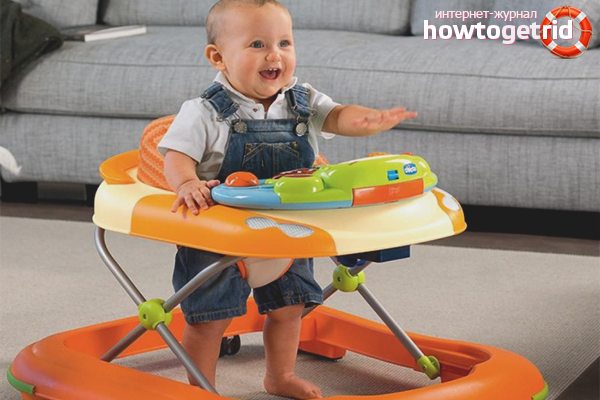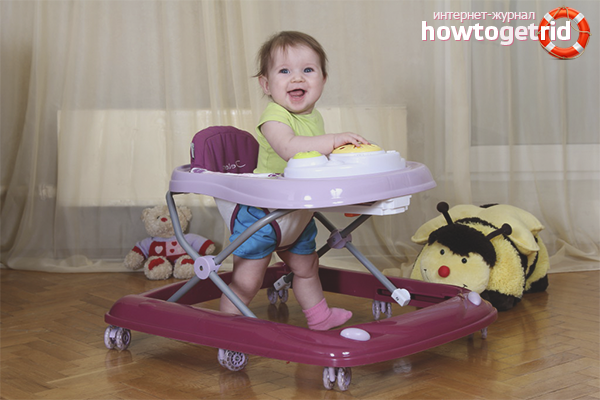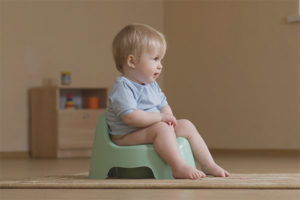The content of the article
Walkers are a special device on wheels, which allows the child to sit tight in a special seat, the risk of falling in this case is minimal. Walkers - this is a good thing primarily for parents - the baby in the walkers is busy, he can independently move around the room, allows his mother to go about their business. In addition, modern models of walkers have a huge amount of entertainment on the top panel - melodies, colorful buttons, toys, mazes and other items. That is, in such walkers the baby is definitely not bored. But is the use of this subject justified?
Walkers - benefit and harm
We have already talked about the useful part of this children's subject. For the most part, walkers need mom to have time to remake a lot of things around the house. And they really save her - the baby can spend hours in this interesting device. However, walkers are fraught with serious danger. Improper use of them leads to the fact that the baby may begin to have health problems.
The most important mistake parents make is that they put a small child on the walker. A baby whose spine has not yet matured is not able to withstand such serious loads as the vertical position of the body. Often, children who walk in walkers cannot begin to walk on their own for a long time. And all because the muscles of the back, lower back and neck develop only in a crawling state. That is, in order to prepare for upright posture, the baby should crawl and train enough, and not walk in walkers. Early use of walkers (up to 6 months) leads to the fact that the child develops scoliosis and other problems with the spine due to a serious load, for which the body is not yet ready. That is why in some countries, walkers are completely discontinued and prohibited for use.
Another negative factor that can become a serious problem in using a walker is the possibility of injury. Many parents, hoping for the safety of the walker, leave the child alone with the device. The wheel of the walker can fall into the recess in the floor, the walker is turned over. Especially carefully you need to monitor the stairs in the house - they need to be closed with special partitions for children. You need to understand that walkers do not exempt from the need to look after the child.
Children who often walk in walkers have one more problem - subsequently, because of the habit of pushing off with socks, they often begin to walk on toes. This is very harmful for the body, because the weight of the child is not distributed to the entire foot. If you do not have walkers, do not buy them, replace the fixture with the arena. If you already have a walker, follow the clear rules so as not to harm your child. The first - you can not put a child on a walker if he does not know how to sit and crawl. This is a serious burden for a fragile spine. It is better to put the baby in the walker no earlier than 8 months. The second rule is to use a walker only 30-40 minutes a day, a maximum of one hour. At other times, the child should crawl to strengthen his muscular corset. The third rule - do not leave the baby alone, even if he is in a walker and there are no bumps nearby. Anything can happen and the adult should be around. If you are ready to follow three simple rules, we will tell you how to teach your child to walk in walkers.
How to teach a child to walk in walkers
First of all, you need to understand that now the child will move independently and will be able to climb anywhere. Cover the corners of the furniture and the doorposts with special silicone pads that can soften a possible blow.Close all sockets that are at the level of growth of the baby, remove electrical appliances and various cords. Household chemicals and other hazardous compounds should be removed from the reach. As noted, you need to close the stairs, if there are any in the house. Only by following these simple rules, you can begin to teach the baby to walk on walkers.
- Having brought a new item into the house, it should be thoroughly washed and disinfected. Indeed, on the shelf of the store, walkers must have touched a lot of people. And your baby will certainly want to get acquainted with a new subject, first of all licking it.
- When walkers appear in the house, do not rush to put the child inside - you can scare him, and he will beware of this item. Let him get acquainted with the new toy, let the kid investigate everything well.
- When the baby ceases to be afraid, carefully put him on the seat. Be careful, any pain can be associated with the subject and the baby subsequently flatly refuses to sit in the walker. The child should be comfortable and convenient.
- Allow the baby to get comfortable in a new position. Let the baby play a little. Then carefully move it with your feet to show the child how to push off the floor. At the same time, push the walkers slightly so that the baby understands that his movement of his legs leads him to move and move independently.
- Adjust the height of the seat so that the baby touches the floor with a full foot, and not just the socks.
- Never put a crying child in a walker, this can cause fright in the baby, and he will not want to use this toy anymore.
- When the baby ceases to be afraid, and will sit quietly in its first transport, you can step back a bit and call the baby with an affectionate word or “entice” him with your favorite toy. The main thing for a child to understand the principle of action is that he is repelled by his feet and this leads to his movement. If the baby succeeds, be sure to praise him.
- If the child is only sitting in the walker, you can take him by the hands and raise his ass a little. You must show the baby that it is not necessary to sit in the walker, it is a device for safe standing. Lift the baby to his feet and slightly release the handles. The child will soon realize that even if he falls, he will not be hurt. This will give him confidence.
- Watch your baby carefully. It so happens that sometimes children move only in one direction, the body is always tilted to the side. Try to motivate the baby to move in the opposite direction. If it doesn’t work out, it’s worthwhile to refuse walkers so as not to contribute to the development of curvature of the spine.
- Do not roll the child in the walker, otherwise the legs will drag on the floor, the baby will perceive the walker as a fun ride, and then starts asking you to ride it. You can only move the body of the walker simultaneously with the rearrangement of the child's legs. Your task in this is to let the child understand how this thing works.
Usually the child quickly gets used to the walker, and begins to use them within a few days after the appearance of a new “toy” in the house.
Walkers are a special item that can be incredibly useful and at the same time dangerous for the child. With proper use, walkers can be a real salvation for the capricious baby and his mother - the child will not ask for his hands, but will be able to move around the room and take the toys he needs. But in order not to harm the baby, you need to follow simple safety rules.
Video: walkers - pros and cons











Submit